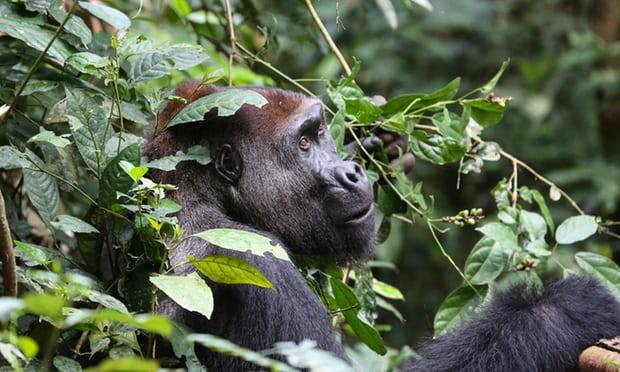
The gut microbiome of great apes fluctuates seasonally, a new survey of gorilla and chimpanzee feces showed. The findings, published this week in the journal Nature Communications, could help scientists better understand the evolution of the human gut microbiome.
Scientists collected and analyzed fecal samples from gorillas and chimpanzees living in the Sangha region of the Republic of Congo. Their survey showed the gut microbiome, the community of microbes living in the intestines of the great apes, took on a markedly different composition during the summer dry period, when the apes’ diet adapts to accommodate the abundance of fruits. During the wet season, apes primarily dine on leaves and bark.
Similar shifts in the makeup of gut bacteria have been observed in the Hadza, a hunter-gatherer people of Tanzania. The diet of the Hadza people is also largely dictated by seasonal availability.
The diets of most humans in modern industrialized society are relatively consistent all year long. Globalized food production systems allow for the consistency as local grocery stores are stocked with a full spread of produce all year long.
“While our human genomes share a great deal of similarity with those of our closest living relatives, our second genome — the microbiome — has some important distinctions, including reduced diversity and the absence of bacteria and archaea that appear to be important for fiber fermentation,” Allison L. Hicks, a researcher at the Center for Infection and Immunity at Columbia University’s Mailman School of Public Health, said in a news release. “Understanding how these lost microbes influence health and disease will be an important area for future studies.”
Each year, the bacteria that help apes break down fibrous plant material is replaced by microbes that consume the mucous that accumulates when apes eat lots of fruit.
“The fact that our microbiomes are so different from our nearest living evolutionary relatives says something about how much we’ve changed our diets, consuming more protein and animal fat at the expense of fiber,” said Brent Williams, an assistant professor of epidemiology at the Center for Infection and Immunity. “Many humans may be living in a constant state of fiber deficiency. Such a state may be promoting the growth of bacteria that degrade our protective mucous layer, which may have implications for intestinal inflammation, even colon cancer.”
Additionally, there are far more gorillas left in the world than previously thought, according to a landmark new survey, with numbers as much as double earlier estimates.
However, their populations are continuing to fall fast, down 20% in just eight years, leaving them critically endangered. Furthermore, 80% of the remaining gorilla troops do not live in protected areas, leaving them vulnerable to the threats the researchers summarise as “guns, germs and [felled] trees”.
The decade-long survey in western equatorial Africa involved almost 9,000km of foot patrols and used the nests that gorillas make every night to assess the population. The scientists covered the entire range of the western lowland gorilla, which accounts for 99% of all living gorillas, now thought to number around 360,000 animals.
Gorillas are vital for the health of the entire forest, the scientists said, because they spread large seeds and their loss is disastrous in the long term. The larger-than-expected population gives hope for gorilla survival, they said if poaching and forest destruction for palm oil can be halted.
“The population could be double,” said Prof Fiona Maisels, from the Wildlife Conservation Society and one of 50-strong international experts who conducted the survey. “But that is not the big story. Just because there are rather a lot of them does not mean they are not very, very vulnerable.” Gorillas breed very slowly, with females taking 11-12 years to reach maturity and only giving birth every four years. “It takes a very long time to build populations back up,” Maisels said.
The survey, published in the journal Science Advances, covered about a quarter of the gorilla’s total range – an area the size of France – which is naturally bounded by the Atlantic Ocean and the Congo and Ubangi rivers. They then used the nest counts and data on important factors including the presence of people, roads and intact forest to produce a sophisticated statistical model.
This allowed them to fill in the gaps between the surveyed areas, unlike previous research. The resulting total was 361,900 gorillas, far higher than the earlier estimates of 150,000 to 250,000. The researchers also assessed the population of the central chimpanzee sub-species, which lives in the same range and represents about a third of all chimps. Their population was 10-80% higher than thought.
It is illegal to kill or capture any great ape in all the nations where they live, but poaching to supply bushmeat to fast-growing cities is rife. Outbreaks of Ebola virus have also decimated populations in recent decades, with “catastrophic” impact on populations, the scientists said. “If Ebola wipes through an area, they all go – 90% of them in six months,” said Maisels.
The most important single factor in determining the survival of gorillas was the presence of park guards to deter poachers, the analysis found. Dominant males are easy to shoot because they attempt to stand up to hunters, trying to protect their group. The males replacing them often kill the babies they have not fathered, compounding the losses.
In contrast, chimpanzees, which spend much more time in trees, usually flee when hunters approach. “They are not as heroic if you like,” said Maisels. “Chimps are cleverer and sneak away very quietly.” Local cultural taboos against eating chimp meat also helped protect them in a few locations. The chimp population did not show a significant decline in the study period from 2008 to 2013.
“The advice we would like to offer is to keep up the anti-poaching effort,” said Maisels. “That gets rid of the immediate worry. But the future worry is the removal of forest for agricultural development. If a big area of forest is turned into an oil palm or rubber plantation, it is not habitat for anything anymore, except weeds.”
Only 20% of the gorilla’s range is in protected areas and the researchers said the vast majority of unprotected forests are being opened up to logging and deforestation: “It is vital that we step up our efforts to conserve great apes.”
The study produced a total population estimate for the central chimpanzee of nearly 130,000 individuals. Photograph: Emma Stokes/WCS
Advertisement
The situation varies widely by country, said Maisel, with Gabon having good national policies while the war-torn Central African Republic is struggling to govern at all. Congo is a hotspot for gorillas, she said and could play a vital role in conservation.
Liz Williamson, great apes coordinator for the International Union for Conservation of Nature’s red list, said a combination of responsible development and a network of well-managed parks would provide a winning formula: “Our study has revealed that it is not too late to secure a future for gorillas.”
The western lowland gorilla is by far the most populous subspecies. There are about 3,600 eastern lowland or Grauer’s gorillas – a fall of 75% in last 20 years – 800 mountain gorillas and just 200-300 Cross River gorillas.






